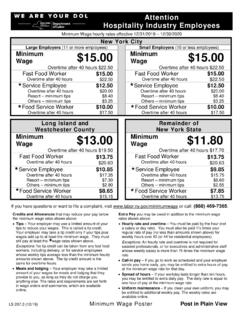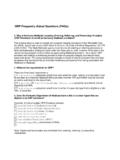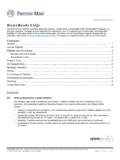Transcription of Wage Theft Prevention Act Frequently Asked Questions
1 wage Theft Prevention Act Frequently Asked Questions (FAQ) The wage Theft Prevention Act, which goes into effect April 9, 2011, amends the notice of wage rate requirements and expands the civil and criminal remedies that are available when employers fail to comply with these provisions. Section 195 of the Labor Law, as amended by the Act, requires that employers provide notice to employees of their rate(s) of pay, designated pay day, the employer s intent to claim allowances (like tip or meal allowances) as part of the minimum wage , and the basis of wage payment (whether paying by hour, shift, day, week, piece, etc.). The law requires that the notice contain the employer's "doing business as" names, and that it be provided at the time of hiring and within 7 days of a change if the change is not listed on the employee s pay stub for the following pay period.
2 The notice must be provided in the employee s primary language, as identified by the employee, through translated notices provided by the Department of Labor. The Act also amends the recordkeeping and statutory payroll record and paystub requirements to include information currently required pursuant to regulation, and requires employers to maintain copies of payroll records for six years (as is currently required by regulation). The Act clarifies and expands the Department of Labor s authority to enforce the Labor Law, and expands an employee s ability to bring complaints and private actions for such violations. The protection against prohibited retaliation is strengthened by closing loopholes on what actions constitute retaliation and expands the remedies available to employees.
3 Based upon inquiries received by the Department in anticipation of the Act s effective date, the following are Frequently Asked Questions regarding the notice requirements of the wage Theft Prevention Act: 1. What is the wage Theft Prevention Act? A new law, effective April 9, 2011, gives greater protection to workers, and makes changes in the way they are notified of their pay rates and receive wage statements. 2. Who is covered by the law? All private sector employers are covered. If you have employees who work in other states they are not covered. Federal, state and local government employers are also not covered, but it is important to note that charter schools, private schools, and not-for-profit corporations are covered, as they are not public entities.
4 3. What does the law require? Workers have to receive pay notices at the time of hire and when there are changes in the information on the pay notices, proper wage statements, and be free from retaliation for complaining about possible violations of the Labor Law. 4. What is required in the pay notice given to workers? The Notice must contain the following information: The employee s rate(s) of pay; The basis of the employee s rate(s) of pay ( by the hour, shift, day, week, salary, piece, commission, or other); Whether the employer intends to claim allowances as part of the minimum wage , including tip, meal, or lodging allowances, and the amount of those allowances; The employee s regular pay day designated by the employer in accordance with the frequency of pay requirements in the Labor Law1; The name of the employer and any "doing business as" names used by the employer.
5 The physical address of the employer's main office or principal place of business, and a mailing address if different; The telephone number of the employer; Any such other information as the commissioner deems material and necessary. 5. What if a worker s primary language is not English? Notices need to be given in a worker s primary language if the Department of Labor provides notice templates in that language. Otherwise the notice need only be provided in English. Those templates are available on our website. 6. For what languages will the Department provide templates? Templates will be available in English, Spanish, Chinese, Korean, Creole, Polish and Russian.
6 They will cover a number of likely situations companies may face. You can choose the one which meets your needs. 1 Section 191 of the New York State Labor Law regulates how Frequently an employee must be paid. Under that Section, manual workers must be paid on a weekly basis, clerical and other workers, must be paid according to the terms of their employment agreement and not less Frequently than semi-monthly on regular pay days designated in advance by the employer, railroad workers must be paid on or before Thursday of each week the wages earned during the seven-day period ending in Tuesday of the preceding week; commission salespersons must be paid in accordance with their agreed terms of employment but not less Frequently than once in each month and not later than the last day of the month following the month in which the wages are earned.
7 And employees employed in a bona fide executive, administrative or professional capacity whose earnings are in excess of nine hundred dollars a week must be paid according to the terms of their employment contract. 7. Do I have to use the Department s templates? No, employers can develop their own notices so long as they contain all the information required by the law. 8. When are pay notices required? Notices are required at the time of hire, and when there are changes in the information on the pay notices. 9. May the notice be included in letters and/or employment agreements provided to new hires? Yes, but must be on its own form. 10. Can a worker waive the notice requirement?
8 No. 11. Can the notice be given electronically? Yes, but their needs to be a system where the worker can acknowledge the receipt of the notice and print out a copy of the notice. 12. What if a worker refuses to sign the notice? The employer should still give the notice to the worker and note the worker s refusal on its copy of the notice. 13. Do employers have to keep a copy of the notice? Yes. Notices must be kept for six years and be available to the Department upon request. 14. Do I have to give a new notice every time a wage rate changes? Except for the employers in the hospitality industry, notice is not required where there is an increase in a rate and the new rate is shown on the next payment of wages.
9 For any reduction of wage rate, an employee must be notified in writing prior to the reduction being implemented. Employers in the hospitality industry currently need to give a new notice every time a wage rate changes. 15. What procedures should be followed if an employee has multiple pay rates? An employer must put all pay rates on the wage statement. 16. Do workers exempt from state overtime requirements still need to get a pay notice? Yes. 17. Does the employer have to identify the specific state exemption for workers exempt from overtime requirements? No. 18. What should we do if the worker has multiple hourly or piece rates? The purpose of the notice is to inform workers of the wage rates that apply to them.
10 Multiple rates need to be identified either on the notice or on a separate sheet attached to the notice. Only the rates used to determine a worker s pay need be shown on the wage statement for that period. 19. What about salespersons whose wages are all or partially based on commissions? Labor Law Section 191(1)(c) already requires commission salespersons to receive and sign for a copy of their commission agreement. This agreement should be attached to the pay notice and a copy of each document kept by the employer. 20. What if I have a bonus or incentive plan on a weekly or less frequent time period? So long as the employee initially was given a description or it is clearly shown on the wage statement for the period in which it is paid, no additional notice is required.














